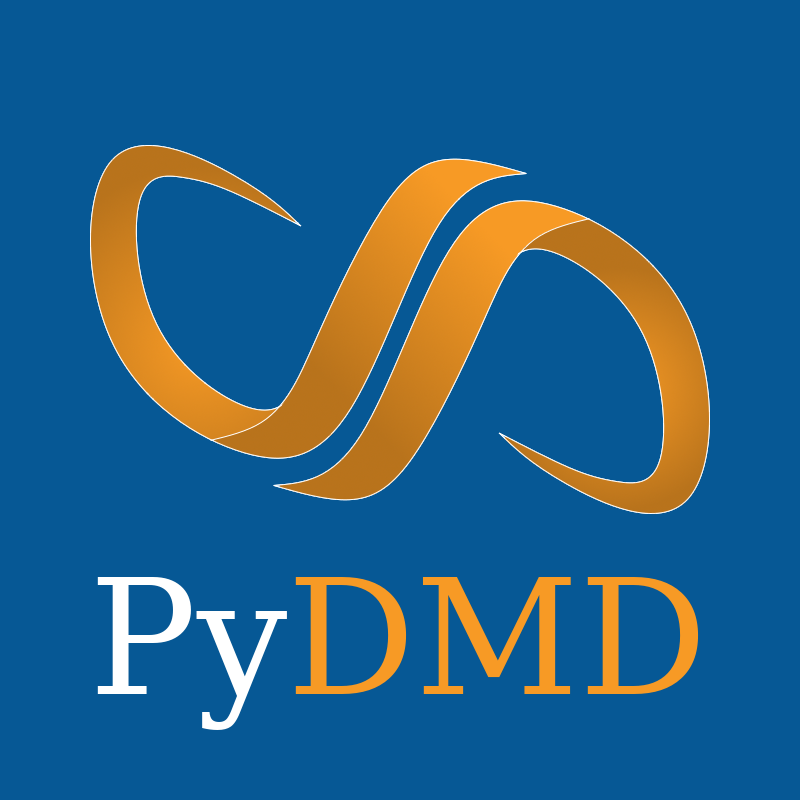- Description
- Dependencies and installation
- Examples and Tutorials
- Awards
- References
- Developers and contributors
- Funding
PyDMD is a Python package designed for Dynamic Mode Decomposition (DMD), a data-driven method used for analyzing and extracting spatiotemporal coherent structures from time-varying datasets. It provides a comprehensive and user-friendly interface for performing DMD analysis, making it a valuable tool for researchers, engineers, and data scientists working in various fields.
With PyDMD, users can easily decompose complex, high-dimensional datasets into a set of coherent spatial and temporal modes, capturing the underlying dynamics and extracting important features. The package implements both standard DMD algorithms and advanced variations, enabling users to choose the most suitable method for their specific needs. These extensions allow to deal with noisy data, big dataset, control variables, or to impose physical structures.
PyDMD offers a seamless integration with the scientific Python ecosystem, leveraging popular libraries such as NumPy and SciPy for efficient numerical computations and data manipulation. It also offers a variety of visualization tools, including mode reconstruction, energy spectrum analysis, and time evolution plotting. These capabilities enable users to gain insights into the dominant modes of the system, identify significant features, and understand the temporal evolution of the dynamics.
PyDMD promotes ease of use and customization, providing a well-documented API with intuitive function names and clear parameter descriptions. The package is actively maintained and updated, ensuring compatibility with the latest Python versions and incorporating user feedback to improve functionality and performance. We provide many tutorials showing the characteristics of the software. See the Examples section below and the Tutorials to have an idea of the potential of this package.
PyDMD is available on PyPI, therefore you can install the latest released version with:
> pip install pydmdTo install the bleeding edge version, clone this repository with:
> git clone https://github.com/PyDMD/PyDMDand then install the package in development mode:
> pip install -e .The core features of PyDMD depend on numpy and scipy. In order to use the plotting functionalities you will also need matplotlib.
You can find useful tutorials on how to use the package in the tutorials folder.
Here we show a simple application (taken from tutorial 2): we collect few snapshots from a toy system with some noise and reconstruct the entire system evolution.
 The original snapshots used as input for the dynamic mode decomposition
The original snapshots used as input for the dynamic mode decomposition

The system evolution reconstructed with dynamic mode decomposition
First prize winner in DSWeb 2019 Contest Tutorials on Dynamical Systems Software (Junior Faculty Category). You can read the winner tutorial (PDF format) in the tutorials folder.
To implement the various versions of the DMD algorithm we follow these works:
- Kutz, Brunton, Brunton, Proctor. Dynamic Mode Decomposition: Data-Driven Modeling of Complex Systems. SIAM Other Titles in Applied Mathematics, 2016. [DOI] [bibitem].
- Gavish, Donoho. The optimal hard threshold for singular values is 4/sqrt(3). IEEE Transactions on Information Theory, 2014. [DOI] [bibitem].
- Matsumoto, Indinger. On-the-fly algorithm for Dynamic Mode Decomposition using Incremental Singular Value Decomposition and Total Least Squares. 2017. [arXiv] [bibitem].
- Hemati, Rowley, Deem, Cattafesta. De-biasing the dynamic mode decomposition for applied Koopman spectral analysis of noisy datasets. Theoretical and Computational Fluid Dynamics, 2017. [DOI] [bibitem].
- Dawson, Hemati, Williams, Rowley. Characterizing and correcting for the effect of sensor noise in the dynamic mode decomposition. Experiments in Fluids, 2016. [DOI] [bibitem].
- Kutz, Fu, Brunton. Multiresolution Dynamic Mode Decomposition. SIAM Journal on Applied Dynamical Systems, 2016. [DOI] [bibitem].
- Erichson, Brunton, Kutz. Compressed dynamic mode decomposition for background modeling. Journal of Real-Time Image Processing, 2016. [DOI] [bibitem].
- Le Clainche, Vega. Higher Order Dynamic Mode Decomposition. Journal on Applied Dynamical Systems, 2017. [DOI] [bibitem].
- Andreuzzi, Demo, Rozza. A dynamic mode decomposition extension for the forecasting of parametric dynamical systems. 2021. [arXiv] [bibitem].
- Jovanović, Schmid, Nichols Sparsity-promoting dynamic mode decomposition. 2014. [arXiv] [bibitem].
You can find a list of the scientific works using PyDMD here.
The main developers are
We warmly thank all the contributors that have supported PyDMD!
Do you want to join the team? Read the Contributing guidelines and the Tutorials for Developers before starting to play!
Made with contrib.rocks.
We use pytest to run our unit tests. You can run the whole test suite by using the following command in the base directory of the repository:
pytestA significant part of PyDMD has been written either as a by-product for other projects people were funded for, or by people on university-funded positions. There are probably many of such projects that have led to some development of PyDMD. We are very grateful for this support!
Beyond this, PyDMD has also been supported by some dedicated projects that have allowed us to work on extensions, documentation, training and dissemination that would otherwise not have been possible. In particular, we acknowledge the following sources of support with great gratitude:
- H2020 ERC CoG 2015 AROMA-CFD project 681447, P.I. Professor Gianluigi Rozza at SISSA mathLab.
- FSE HEaD project Bulbous Bow Shape Optimization through Reduced Order Modelling, FVG, Italy.







